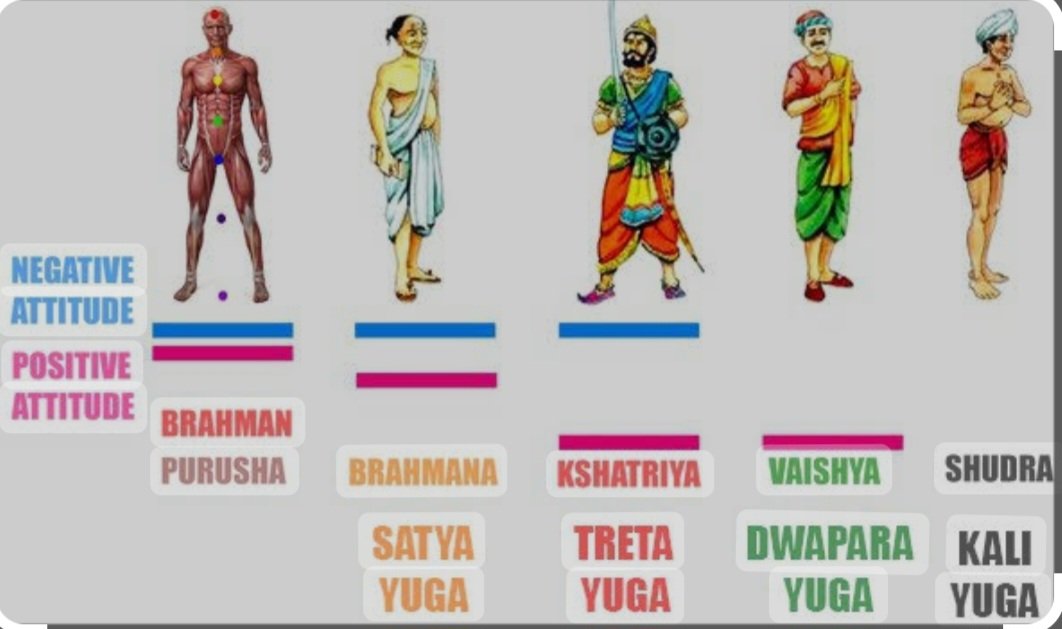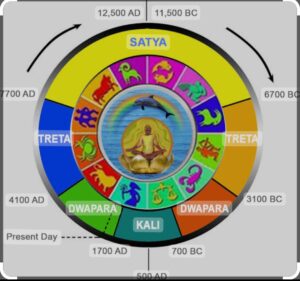4 Yugas of Hinduism – Satya, Treta, Dvapara & Kali Yuga-Cosmic Ages of Human Life
- In Hinduism, there are four Yugas, also known as cosmic ages or epochs. These Yugas follow a cycle and are believed to represent different stages of human civilization and spiritual development.
The four Yugas Of Hinduism are:
1. Satya Yuga (also called Krita Yuga):
Satya yuga, also known as the Golden Age, is the first of the four stages the world goes through as part of the cycle of Yugas, according to Hindu cosmology. Each Yuga is characterized by specific virtues and qualities, and Satya yuga is considered the age of truth and righteousness.
1. Satya Yuga Age/cycle – The Time Period in Years : It lasts for 17,28,000 (4800 divine) years.
2. Virtue and Righteousness: People in Satya yuga are believed to be inherently virtuous, honest, and spiritually enlightened. Truthfulness and righteousness prevail in every aspect of life.
3. Longevity and Health: Human life in Satya yuga is said to be significantly longer, with people living for thousands of years. Disease and suffering are rare, and people enjoy excellent health and vitality.
4. Spirituality and Wisdom: The society is deeply spiritual, and people are naturally inclined towards meditation, yoga, and self-realization. The pursuit of spiritual knowledge and enlightenment is a common practice.
5. Harmony with Nature: There is a perfect balance between humans and nature. The environment is clean and abundant, and people live in harmony with animals and plants.
6. Absence of Greed and Envy: Material desires and greed are almost nonexistent. People are content and satisfied with what they have, leading to a peaceful and harmonious society.
7. Divine Presence: There is a direct connection with the divine, and gods and goddesses are believed to interact with humans regularly. Miracles and divine interventions are common.
Satya yuga is followed by Treta Yuga, Dvapara Yuga, and finally, Kali Yuga, which is the age of darkness and decline. The cycle then repeats itself.
2. Treta Yuga:
Treta Yuga is the second of the four stages the world goes through in the cycle of Yugas, according to Hindu cosmology. It follows Satyug and precedes Dvapara Yuga. Treta Yuga is characterized by a decline in virtue and a decrease in righteousness compared to Satyug, but it is still considered an age of relative prosperity and spiritual awakening.
Here are some key aspects of Treta Yuga:
1. Treta Yuga Age/cycle – The Time Period in Years : It lasts for 12,96,000 (3600 divine) years according to Hindu cosmology, making it shorter than Satyug but significantly longer than the subsequent Yugas.
2. Decline in Virtue:Compared to Satyug, virtue and righteousness decline in Treta Yuga. People become less spiritually aware and honest, leading to a decrease in moral values. However, there is still a fundamental sense of goodness and dharma (righteousness) in society.
3. Spiritual Practices: Despite the decline, spiritual practices such as meditation, yoga, and rituals continue to be prevalent. People seek spiritual knowledge and engage in religious ceremonies to connect with the divine.
4. Technology and Civilization: Treta Yuga is believed to be a time of advanced technology and civilization. There are significant developments in various fields, including architecture, agriculture, and arts. People build grand cities and palaces, and society becomes more organized.
5. Epics and Legends: Treta Yuga is the age in which significant events described in ancient Hindu epics like the Ramayana occur. Lord Rama, an incarnation of the god Vishnu, is believed to have lived during this period. His life and adventures are extensively documented in the Ramayana, making Treta Yuga a central theme in Hindu mythology.
6. Divine Influence: Although the direct interaction between humans and gods decreases compared to Satyug, divine beings still have a presence in people’s lives. Miracles and supernatural occurrences are relatively common.
Treta Yuga sets the stage for the subsequent decline in Dvapara Yuga and the eventual darkness of Kali Yuga. Each Yuga is cyclical and represents a specific phase in the eternal cosmic order, reflecting the cyclical nature of time and existence in Hindu philosophy.
3. Dvapara Yuga:
Dvapara Yuga is the third of the four stages in the cycle of Yugas, according to Hindu cosmology. Following Treta Yuga, Dvapara Yuga represents a further decline in virtue, spirituality, and righteousness. Here are the key characteristics of Dvapara Yuga:
1. Dvapara Yuga Age/cycle – The Time Period in Years : It lasts for 8,64,000 (2400 divine) years, making it shorter than Treta Yuga but longer than the subsequent Kali Yuga.
2. Decrease in Virtue: Virtue and righteousness continue to decline in Dvapara Yuga. People become more materialistic, and there is a gradual erosion of moral values. The practice of virtue becomes increasingly difficult, and people start to indulge in dishonesty and deception.
3. Religious Rituals and Ceremonies: Religious rituals and ceremonies become more elaborate during Dvapara Yuga. People perform intricate rituals and sacrifices in an attempt to gain spiritual merit and appease the gods. However, the true essence of these practices often gets lost in the complexity of the rituals.
4. Intellectual Development: Despite the moral decline, there are advancements in intellectual pursuits. Knowledge of arts, sciences, and philosophy is cultivated, although it is often misused for personal gain rather than the collective welfare of society.
5. Avataras and Divine Incarnations: Dvapara Yuga is the age in which several significant divine incarnations, known as avataras, are believed to have taken place according to Hindu mythology. The most notable among these is Lord Krishna, considered the eighth incarnation of Lord Vishnu. The events of the Mahabharata, a major ancient Indian epic, including the Bhagavad Gita, are associated with this period.
6. Decline in Human Lifespan: Human lifespan continues to decrease in Dvapara Yuga. People live for several thousand years, but the average lifespan is significantly reduced compared to the earlier Yugas.
7. Divine Influence and Miracles: Divine influence remains present, but miracles become rarer. People’s faith in the divine is tested, and skepticism starts to grow.
Dvapara Yuga sets the stage for the final stage in the Yuga cycle, Kali Yuga, which is characterized by a drastic decline in virtue, spirituality, and moral values. The Yuga cycle is a recurring pattern in Hindu cosmology, symbolizing the cyclical nature of time, creation, and dissolution in the universe.
4. Kali Yuga:
Kali Yuga, also known as the Age of Darkness, is the last of the four stages in the cycle of Yugas, according to Hindu cosmology. It is characterized by a drastic decline in virtue, morality, and spirituality. Kali Yuga is considered the most challenging and turbulent period in the Yuga cycle.
Here are the key characteristics of Kali Yuga:
1. Kali Yuga Age/cycle – The Time Period in Years : It is believed to last for 4,32,000 (1200 divine) years, making it the shortest of the four Yugas. Despite its shorter duration, it is believed to be the most spiritually challenging period.
2. Decline in Virtue: Virtue and righteousness are at their lowest in Kali Yuga. Greed, dishonesty, violence, and other negative qualities dominate human behavior. Moral and ethical values deteriorate significantly, leading to widespread corruption and deceit.
3. Spiritual Degradation: The spiritual awareness of humanity reaches its lowest point in Kali Yuga. People are easily distracted by material pursuits and lose interest in spiritual practices. The pursuit of sensual pleasure becomes the primary focus of life.
4. Conflict and Strife: Kali Yuga is marked by an increase in conflicts, wars, and social unrest. Society is plagued by divisions, prejudices, and animosity among different groups and communities. People are quick to anger and engage in destructive behaviors.
5. Deterioration of Family and Social Structures: Family values and social structures break down in Kali Yuga. Relationships become shallow, and there is a lack of empathy and understanding among family members. Traditional values and cultural norms erode, leading to a sense of moral chaos.
6. False Teachings and Deception: False prophets and misleading teachings become prevalent. People are easily swayed by deceptive ideologies and charlatans, leading them away from genuine spiritual knowledge.
7. Environmental Degradation: The environment suffers due to human greed and exploitation. Natural resources are depleted, leading to ecological imbalances, climate change, and environmental disasters.
8. Spiritual Opportunities: Despite the challenges, some spiritual opportunities exist even in Kali Yuga. Spiritual texts and teachings are still available, and individuals who sincerely seek spiritual truth can find guidance. However, genuine spiritual masters are rare.
Kali Yuga is believed to be a period of intense spiritual testing, where individuals face numerous challenges to maintain their faith and integrity. According to Hindu cosmology, after the completion of Kali Yuga, the cycle of Yugas restarts with a new Satyug, signifying the eternal nature of the cosmic order.
SATYUG FIRST COSMIC AGE OF HUMAN LIFE



nice information
I enjoy what you guys are usually up too. This sort of clever work aand exposure!
Keeep up the fantastic works guys I’ve added you guys to my own blogroll.
Shall we exchange links? My website http://fertus.shop/info/
My website http://www.yiqijj.com